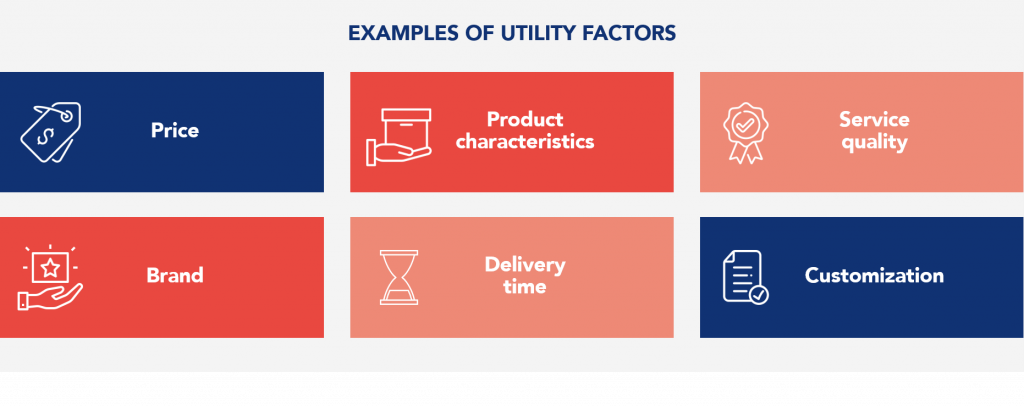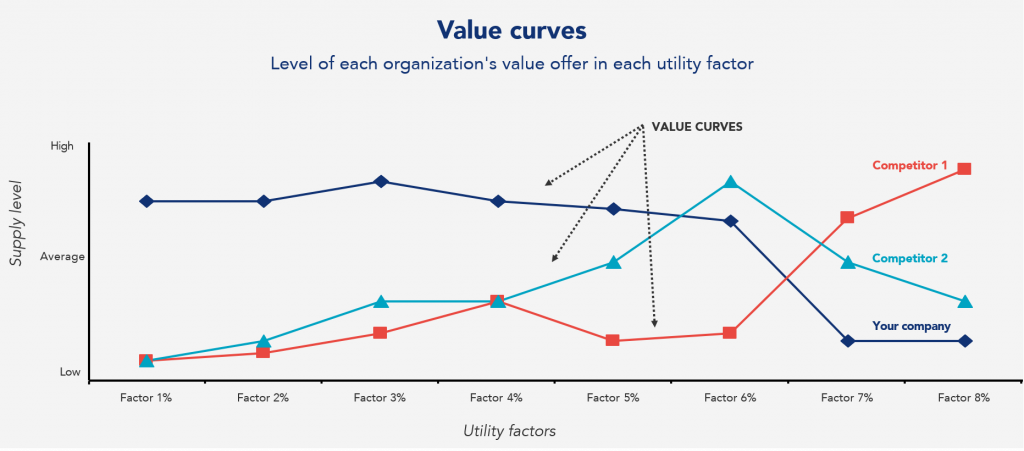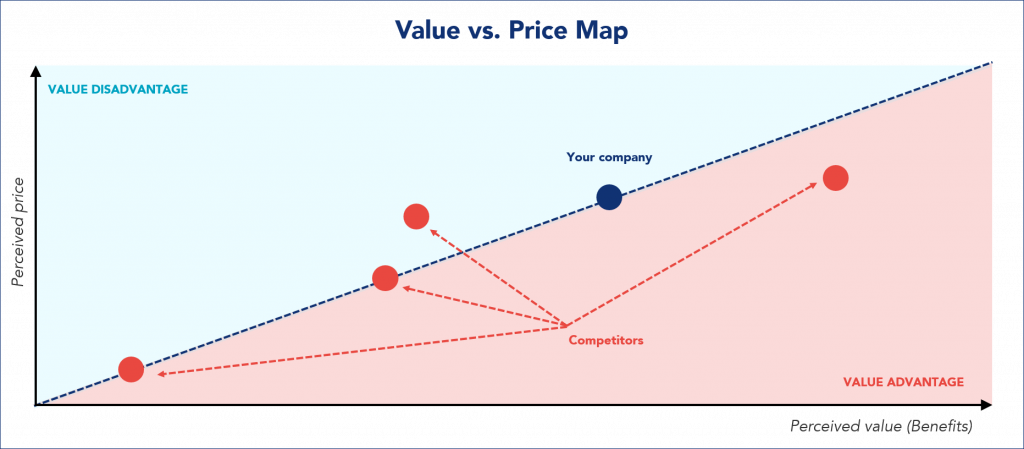It is a constant concern for all companies to maintain a pricing strategy that allows them to make a profit. The real challenges usually arise when companies realize that their competitors are increasing their market share. The most immediate response is often to give customers discounts. This situation could be avoided, in many cases, if the company managed to increase the customer’s perception of the value of its products or services. It is in this context that the paradigm shift to value selling emerges.
Identify customer value
Companies need to have a process in place that allows them to better understand their value propositions, identify gaps, and transition to an approach that demonstrates the total value of products and services to their customers. A value-selling approach allows companies to set their margin according to the value provided to the customer.
If we ask customers how important price is, a large percentage will say that it is the main factor. But a closer look shows that, in reality, a large proportion of customers care as much or more about the benefits the product offers them than the price. Thus, a sales approach that communicates a holistic view of value can positively affect the way customers decide during the buying process.
The transition to value-based sales involves a key shift in existing sales approaches and marketing messages. There are three key components to implementing a value-selling approach:
- Understand the customer’s buying criteria
- Develop a new set of standards to support sales teams and train them in the new methods
- Develop metrics and systems to track performance.
Product value: understand the customer’s buying criteria
Value selling requires an understanding of the true value of the product to the customer. The first step is an analysis designed to uncover the key criteria that customers use to make buying decisions.
While most experienced salespeople know with some accuracy what matters to customers, the most effective methodology is to get this information from the customers themselves. Questionnaires or interviews should be conducted with customers to determine the most relevant decision factors and their weight.
The analysis aims to list the most important factors for customers in their buying decision, rank them in order of relevance, and evaluate the company and the competition on these same factors.

Based on the collected data, it is possible to build value curves, in which one can analyze which factors are the most important, and their respective weights, as well as information on how customers evaluate the company and its competition on these same factors.

Objectively speaking, the price and value of products or services are the only parameters that really matter to the client, so it is important that organizations know the interaction between them. The value vs price matrix allows the analysis of these interactions. Having the information from the value curves, the process of constructing this matrix becomes simpler. The total value is calculated by taking the weighted average of the scores assigned to each factor.

Under conditions of perfect competition, in which the customer has full knowledge of the market, all products and services would be located around the balance line. But what happens, in reality, is that they are often above and below as a result of customers’ imperfect knowledge of the options available within the market or due to other factors.
Generally, products above the line lose market share over time, while those below gain, as customers realize that there are products that provide more value for the same money.
This value vs. price map can help companies visualize their current competitive position in the market and evaluate the options available: changing the price of the product, changing the value offered, to some or all customers, or any combination of the two. For example, a product below the balance line may want to hold its value constant, and increase the price, or hold the price, and lower the costs, and thus remove some value. In cases where it is not possible to use the voice of the customer to collect data to build these maps, organizations should not overlook this analysis. Although, in such cases, some of the map information is based on opinions, a rough map is much more useful for strategic purposes than no map at all and can be a good way to take marketing and sales decisions.
Value selling: strategies for communicating quantifiable customer value
After the company understands the real value of its products to its customers, it must develop approaches to guide the sales team in its work. The value selling approach represents a new way for the sales force to engage with customers.
Value-based selling can make a substantial difference in how potential customers view a purchase, because it positions the salesperson as a consultant, guiding the approach to find the best solution to the customer’s needs. Thus, it is consultative selling, as the salesperson adds value throughout the buying process.
In traditional selling methods, the goal is often to convince the customer to buy as much value as possible immediately, without thinking about the future. This can lead to promising more than can be delivered which causes customers to lose trust and credibility in the salesperson and the company.
To implement value selling effectively, it is crucial to think about the customer in the short, medium, and long term. The goal is to increase customer retention rates, and build long-lasting trust, with the focus being to offer what customers need without having to resort to discounts that may jeopardize the viability of the business.
Sales meeting preparation
For value selling to reach its full potential, it is essential to start with good preparation for the customer meeting.
There are a number of essential requirements for a quality meeting with a potential customer:
- The lead must be pre-qualified by a pre-sales team
- The decision-makers must be present at the meeting
- The visit must be scheduled in advance with a defined date and time
- The objectives must be defined (medium-long term sales objective for the account and the objective for this specific sale)
- There must be previous planning and training of the approach to be used
- At the end of the visit, there must be a commitment between the client and the salesperson
- And, finally, there must be a follow-up after the meeting
All of these points contribute to a quality visit and to the achievement of the objectives.
Plan the questions for the needs analysis
For a correct needs analysis, it is essential to formulate a set of questions. The dialogue with the customer should be opened by asking about the needs and current situation. It is necessary to know the customer to propose the best solution.
Some examples of questions to use:
- How is the business evolving?
- How is the company structured?
- What changes would you like to see?
- What are your expectations?
- How much do you expect to save with the new solution?
- What is the cost of your current solutions?
- How are the current problems affecting the business?
Each of these questions allows you to understand the customer’s pains and to understand how their life can be improved. So, when you pitch a solution, you can hit specific points that the customer has mentioned. Instead of a generic pitch, you can present solutions to problems, which only a business expert would know. This helps the proposed solution stand out from the rest.
Know the competition and the company’s main advantage for the customer
It is relevant to know the competitors’ weaknesses to be able to identify the points of differentiation, and their importance for the customer, i.e. why customers should buy from the company, and not from competitors, and how these points of differentiation benefit each specific customer. Only 35% of organizations are able to clearly define their true competitive advantages, and only 14% of organizations have their competitive advantages perceived by customers.
The first step is to identify the points of differentiation, and then to identify how these points can benefit the customer. Value curves are valuable information for this research, as they provide a comparative analysis of the company, and its competitors in the various utility factors from the customer’s point of view.
After the points of differentiation have been identified, it is necessary to prepare open-ended questions to be asked during the visit for the customer to discuss these benefits, and closed-ended questions to obtain agreement.

Calculate the monetary value of the solution for the customer
A fundamental step in value selling is to express in euros the impact of the benefit provided to the customer, i.e. to convert the benefits received by the customer into a financial return for the customer.
There are several ways to identify the value provided to customers:
- Earned value: when the product or service helps the customer earn more money;
- Value saved: When the solution helps potential customers save money by decreasing expenses;
- Risk reduction: When it can be proven that it can significantly reduce the risk that the customer may face and quantify this risk in euros.
For the quantification in euros of the benefit, you need to:
- Specify the quantifiable benefit
- Quantify the benefit
- Value the benefit monetarily
- Express the total value of the benefit per unit
- Demonstrate the real value of the product
If we consider the example of a company that can deliver a certain product faster than a competitor, the sales force must be able to quantify the value to the customer of the faster time to market in the specific market in which the product is being sold.
Think about objections and how to overcome them
A good salesperson must always keep in mind that objections in sales are a positive sign. Objections mean that the customer has shown interest in the product or service, and wants to understand, in detail, how it can help solve a problem.
The salesperson needs to be prepared to respond to objections, and to do this they must:
- Be aware of the products and services they offer
- Understand the company’s purpose
- Study the customer well
- Dominate the behavior of the competitors and the market
- Understand how you can solve the consumer’s needs
To be prepared to deal with objections, you need to listen to the objection, acknowledge the customer’s concern, ask a question that makes the objection a goal (develop a mutual goal that, when realized, removes the objection), listen to the prospect’s response, ask for confirmation of acceptance – ‘yes, I agree’ – and finally get the commitment.
Define closing arguments and techniques
Finally, it is important to think about how you will close the meeting. Customers expect to hear a closing question. Closing questions lead to a commitment, which in turn closes the sale. Examples of closing questions:
- Does the solution I presented make sense? Can I send you a proposal?
- Are there any topics I haven’t mentioned that you would like to add? Can we schedule a next meeting to present the proposal?
- Is our solution able to meet your needs? Can we move to the next step?
All this must be planned and practiced in advance so that the speech is fluid and adapted to the customer in question.
Continuous training and improvement
Value selling represents a new way for the sales force to relate to clients. It is important that leaders and the sales force are involved in the design of the new standards.
All the steps presented so far are preparation for the moment when the salesperson meets the customer. It is crucial that the salespeople can practice the new approach in a safe environment before meeting with the client. Role play is a good method for salespeople to practice the new standards without exposure to the client. In group training sessions, you can practice and review the new methods as a team, and help salespeople prepare for even the most difficult customers. By practicing and continuously improving, salespeople internalize the arguments they must present and adopt the appropriate language for value selling.
When teams are prepared, it is time to plan the start of the customer approach. Directors and team leaders should be the pioneers in adopting the new approach. You can start with specific customers before expanding this new way of working to all clients.
The monitoring of metrics is important for performance evaluation, and this should be done during sales team meetings, where best practices are also shared and successes are celebrated.
In summary, there are several important factors for the successful implementation of the value selling approach: it is necessary to know the customer and the competition well; leaders and the sales force must participate in the design of the solutions; directors and team leaders must be the pioneers in adopting the new approach; salespeople must practice the new approaches in a safe environment and not immediately at the customer; and, finally, monitor the results and continuously improve.
Business growth through value selling
Value selling is one of the best-selling strategies for today’s markets. As competition continues to increase, it is crucial to find points of differentiation to build customer trust and brand loyalty.
By studying the clients, focusing on value-added selling, and providing a clear explanation of exactly what value the solution will deliver to each specific client, this differentiation is developed.
For the customer, it is clear that the salesperson is paying attention to the details and specific needs of each individual. Seeing the relationship as an advantage in the short, medium, and long term.
Value selling can substantially improve average sales prices, and customer conversion and retention rates, making a strong contribution to business growth.
See more on Marketing & Sales
Find out more about improving this business area
